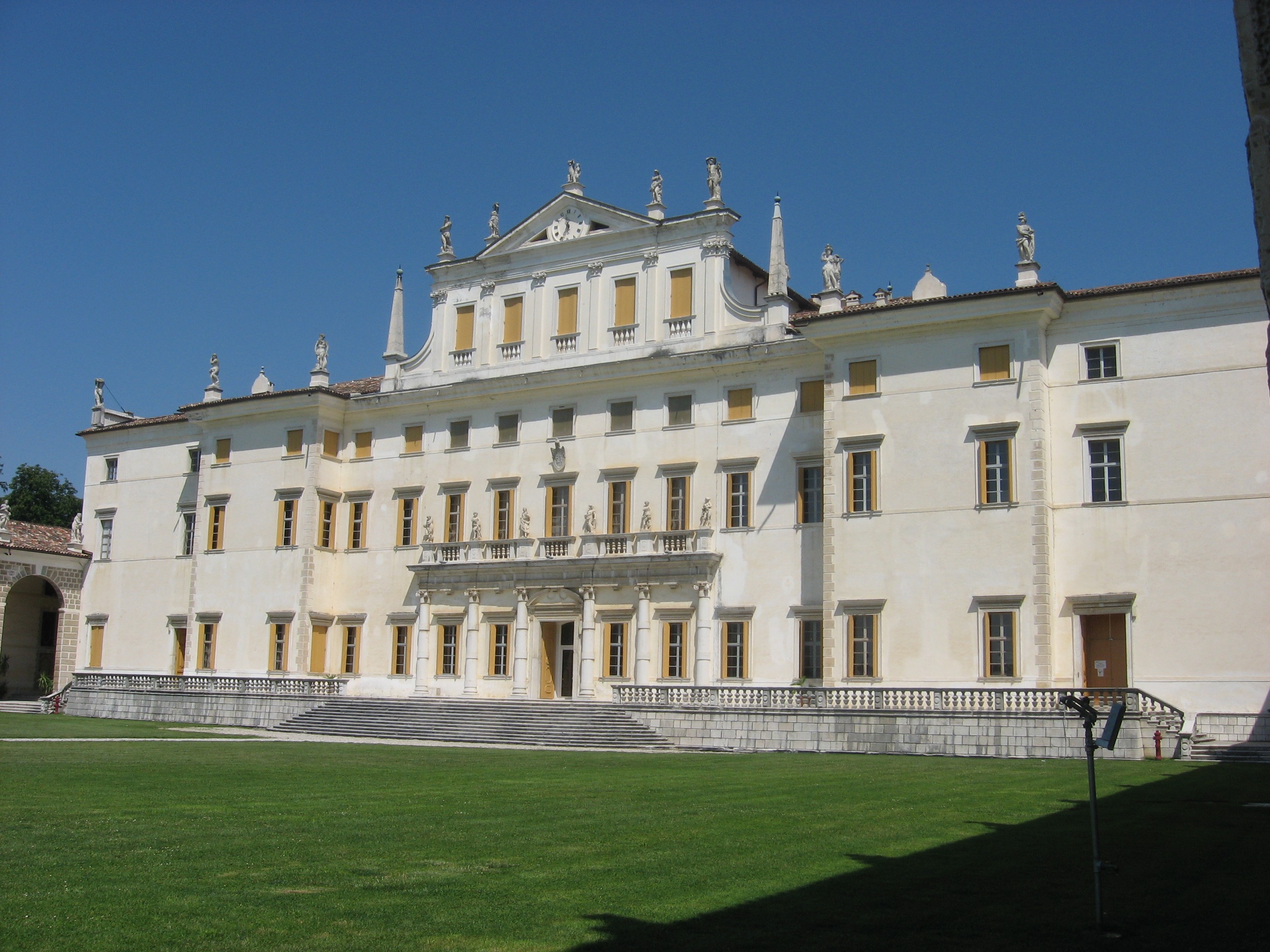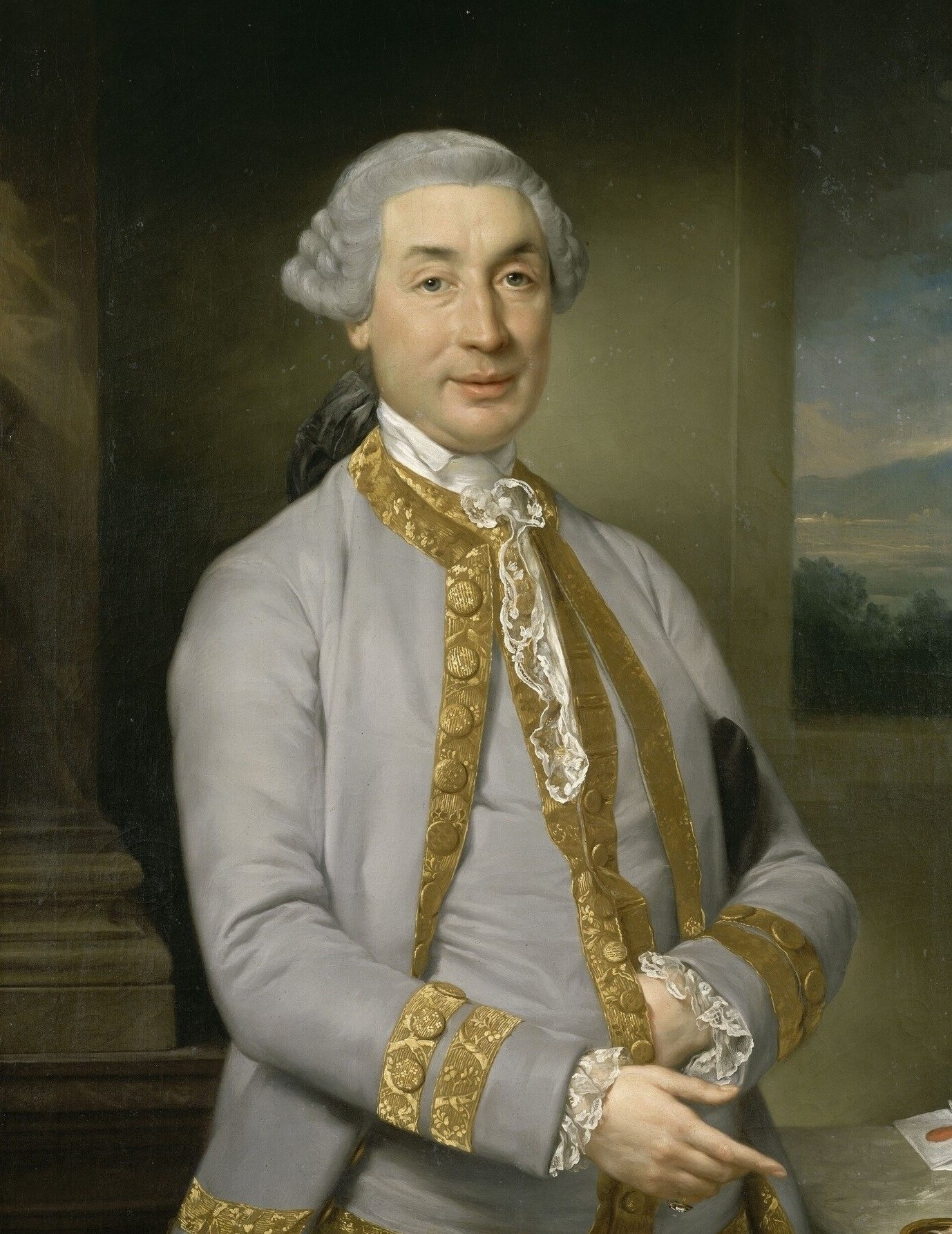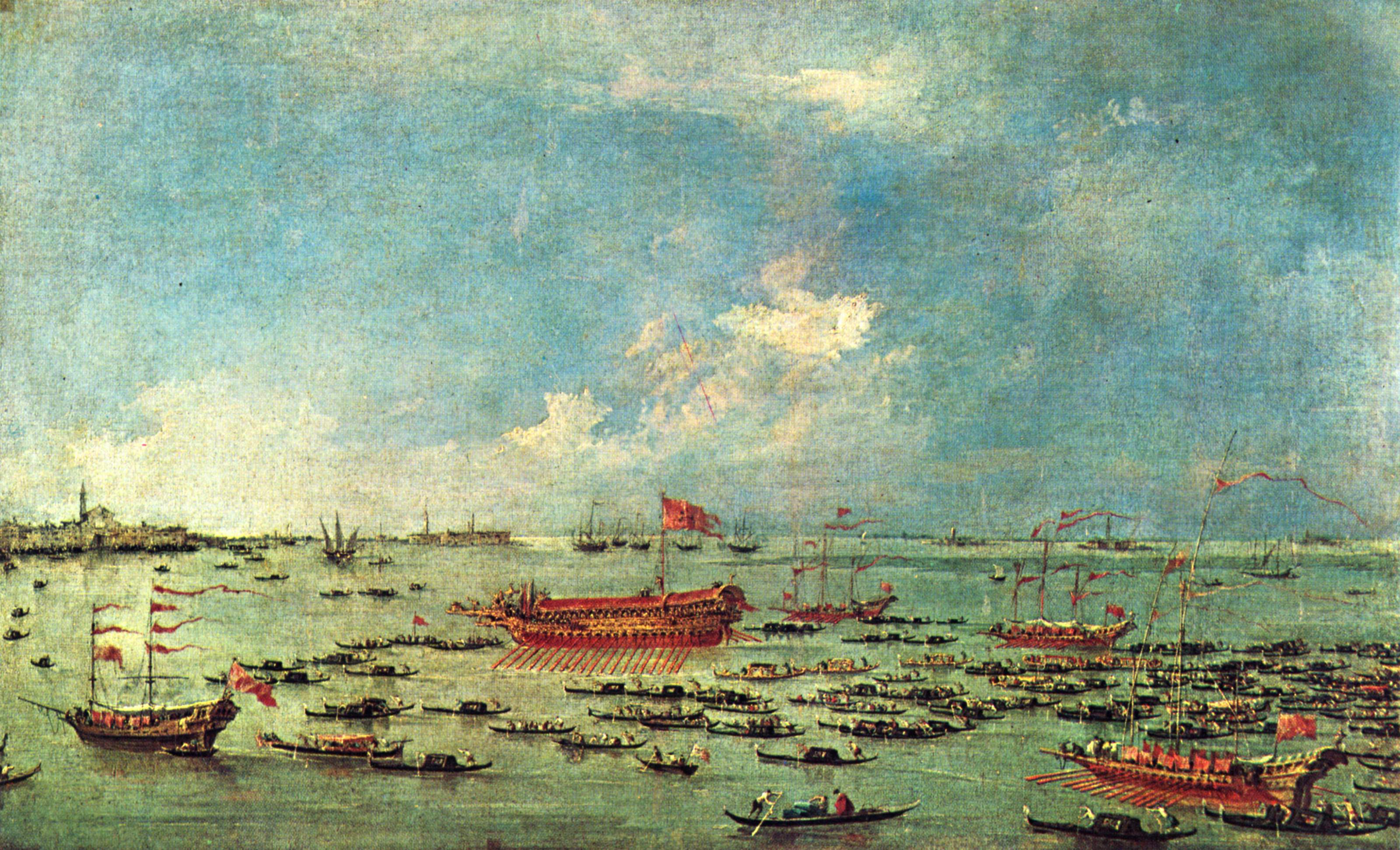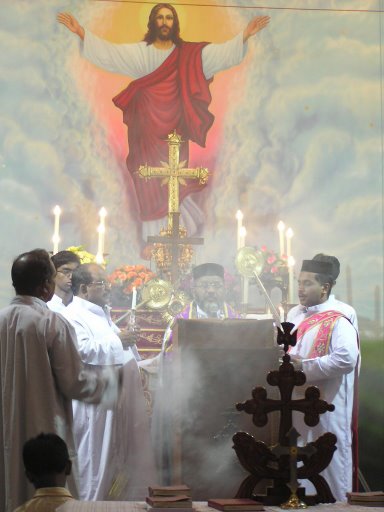|
Corno Ducale
The corno ducale (), a unique ducal hat, was the headgear and symbol of the Doge of Venice. It was a stiff horn-like bonnet, which was made of gemmed brocade or cloth-of-gold and worn over a camauro. The ducal horn was a fine linen cap with a structured peak at the back reminiscent of the Phrygian cap, a classical symbol of liberty. Every Easter Monday the doge headed a procession from St. Mark's basilica to the convent of St. Zechariah's church, where the abbess presented him a new ''camauro'' crafted by the nuns. Origins The origin of the design is uncertain. Venice was heavily influenced by the Orient through trade and cultural exchange. This ceremonial headdress shares similarities with the Phrygian cap or the white crown of Upper Egypt. When Venice was still part of the Eastern Roman (Byzantine) Empire, high-ranking Byzantine soldiers stationed in Venice also wore a headdress reminiscent of the horned Phrygian cap. The first recorded mention of the corno is from the ... [...More Info...] [...Related Items...] OR: [Wikipedia] [Google] [Baidu] |
Most Serene Republic Of Venice
The Republic of Venice ( vec, Repùblega de Venèsia) or Venetian Republic ( vec, Repùblega Vèneta, links=no), traditionally known as La Serenissima ( en, Most Serene Republic of Venice, italics=yes; vec, Serenìsima Repùblega de Venèsia, links=no), was a sovereign state and maritime republic in parts of present-day Italy (mainly northeastern Italy) that existed for 1100 years from AD 697 until AD 1797. Centered on the lagoon communities of the prosperous city of Venice, it incorporated numerous overseas possessions in modern Croatia, Slovenia, Montenegro, Greece, Albania and Cyprus. The republic grew into a trading power during the Middle Ages and strengthened this position during the Renaissance. Citizens spoke the still-surviving Venetian language, although publishing in (Florentine) Italian became the norm during the Renaissance. In its early years, it prospered on the salt trade. In subsequent centuries, the city state established a thalassocracy. It dominated trad ... [...More Info...] [...Related Items...] OR: [Wikipedia] [Google] [Baidu] |
President Of Italy
The president of Italy, officially denoted as president of the Italian Republic ( it, Presidente della Repubblica Italiana) is the head of state of Italy. In that role, the president represents national unity, and guarantees that Italian politics comply with the Constitution. The president is the commander-in-chief of the Italian Armed Forces and chairs the High Council of the Judiciary. A president's term of office lasts for seven years. The incumbent president is former constitutional judge Sergio Mattarella, who was elected on 31 January 2015, and re-elected on 29 January 2022. Qualifications for office The framers of the Constitution of Italy intended for the president to be an elder statesman of some stature. Article 84 states that any Italian citizen who is fifty or older on election day and enjoys civil and political rights can be elected president. The article also states that the presidency is incompatible with any other office; therefore, the president-elect m ... [...More Info...] [...Related Items...] OR: [Wikipedia] [Google] [Baidu] |
Commune Of Venice
The Commune of Venice ( la, Commune Veneciarum) is the title with which the government of the city of Venice and its Republic was designated from 1143. The municipality, similar to other medieval municipalities, was based on the popular power of the assembly, called Concio in Venice. It represented the patriciate of the city with a system of assemblies including the Great Council, Minor Council, Senate and the Council of Forty. Overview Unlike other Italian cities, Venice retained some vestiges of their previous institution of the monarchy embodied by the Doge for setting bounds for power that such assemblies were developing. The leading groups of most of the towns gathered at the time around the core of the ancient patrician families, creating a new merchant aristocracy with the ''Serrata del Maggior Consiglio'' of 1297 and actually took over the power and ousting the popular assembly. In the name of the Commune, it continued to operate the highest representative body of t ... [...More Info...] [...Related Items...] OR: [Wikipedia] [Google] [Baidu] |
Republic Of Venice
The Republic of Venice ( vec, Repùblega de Venèsia) or Venetian Republic ( vec, Repùblega Vèneta, links=no), traditionally known as La Serenissima ( en, Most Serene Republic of Venice, italics=yes; vec, Serenìsima Repùblega de Venèsia, links=no), was a sovereign state and maritime republic in parts of present-day Italy (mainly northeastern Italy) that existed for 1100 years from AD 697 until AD 1797. Centered on the lagoon communities of the prosperous city of Venice, it incorporated numerous overseas possessions in modern Croatia, Slovenia, Montenegro, Greece, Albania and Cyprus. The republic grew into a trading power during the Middle Ages and strengthened this position during the Renaissance. Citizens spoke the still-surviving Venetian language, although publishing in (Florentine) Italian became the norm during the Renaissance. In its early years, it prospered on the salt trade. In subsequent centuries, the city state established a thalassocracy. It dominat ... [...More Info...] [...Related Items...] OR: [Wikipedia] [Google] [Baidu] |
Ludovico Manin
Ludovico Giovanni Manin (; ; 14 May 1725 – 24 October 1802) was a Venetian politician, patrician, and the 120th and last Doge of Venice. He governed the Venetian Republic from 9 March 1789 until its fall in 1797, when he was forced to abdicate by Napoleon Bonaparte. Biography Early life Lodovico Manin was the eldest of five sons of Lodovico III Alvise (1695–1775) and Lucrezia Maria Basadonna, the great-granddaughter of cardinal Pietro Basadonna. He attended the University of Bologna and was a boarder at the noble College of St. Xavier. Manin printed propositions of natural law, which he studied during this period. When Manin began public life he was quickly noticed for his generosity, honesty, kindness, and wealth. He married Elisabetta Grimani (d 1792) on 14 September 1748; she bore him a dowry of 45,000 ducats. Elisabetta had been educated in a monastery in Treviso and was in poor health since childhood. She did not give birth to any children. At 26 he was electe ... [...More Info...] [...Related Items...] OR: [Wikipedia] [Google] [Baidu] |
Napoleon
Napoleon Bonaparte ; it, Napoleone Bonaparte, ; co, Napulione Buonaparte. (born Napoleone Buonaparte; 15 August 1769 – 5 May 1821), later known by his regnal name Napoleon I, was a French military commander and political leader who rose to prominence during the French Revolution and led successful campaigns during the Revolutionary Wars. He was the ''de facto'' leader of the French Republic as First Consul from 1799 to 1804, then Emperor of the French from 1804 until 1814 and again in 1815. Napoleon's political and cultural legacy endures to this day, as a highly celebrated and controversial leader. He initiated many liberal reforms that have persisted in society, and is considered one of the greatest military commanders in history. His wars and campaigns are studied by militaries all over the world. Between three and six million civilians and soldiers perished in what became known as the Napoleonic Wars. Napoleon was born on the island of Corsica, not long aft ... [...More Info...] [...Related Items...] OR: [Wikipedia] [Google] [Baidu] |
The Fall Of The Venetian Republic
''The'' () is a grammatical article in English, denoting persons or things that are already or about to be mentioned, under discussion, implied or otherwise presumed familiar to listeners, readers, or speakers. It is the definite article in English. ''The'' is the most frequently used word in the English language; studies and analyses of texts have found it to account for seven percent of all printed English-language words. It is derived from gendered articles in Old English which combined in Middle English and now has a single form used with nouns of any gender. The word can be used with both singular and plural nouns, and with a noun that starts with any letter. This is different from many other languages, which have different forms of the definite article for different genders or numbers. Pronunciation In most dialects, "the" is pronounced as (with the voiced dental fricative followed by a schwa) when followed by a consonant sound, and as (homophone of the archaic pro ... [...More Info...] [...Related Items...] OR: [Wikipedia] [Google] [Baidu] |
Nicolò Marcello
His tomb Nicolò Marcello (c. 1399 – 1 December 1474) was the 69th Doge of Venice, elected in 1473. He held office for a short period, from 13 August 1473 to 1 December 1474. Said to have been inspired by a previous painting dating from the 15th century, Titian painted Nicolo Marcello's portrait long after his death. Life Born a member of the Marcello family, Nicolò was a trader with the Orient before he undertook various important public positions in the Republic of Venice such as provost of the Council of Ten, ducal councillor, and procurator of St Mark's. Marcello married twice: first with Bianca Barbarigo and later with Contarina Contarini, with whom he had a daughter. Doge In the 1473 election for doge, Marcello prevailed against the future doges Pietro Mocenigo and Andrea Vendramin. During his brief reign he devoted himself to reorganizing Venice's state finances. He introduced new silver coins that were called ''Marcello''. In his will Marcello bequeathed most ... [...More Info...] [...Related Items...] OR: [Wikipedia] [Google] [Baidu] |
Lorenzo Celsi
Lorenzo Celsi (born Venice, c. 1310 – died there 18 July 1365) was a Venetian statesman who served as the 58th Doge of Venice, from 16 July 1361 until his death. Biography He was the son of a rich Celsi family, and was previously noted for leading a flotilla against Genoa to help preserve Venetian interests. He was married to Marchesina Ghisi. During his reign, Celsi confronted the revolt of St. Tito in Crete, a rebellion that overthrew the official Venetian authorities and attempted to create an independent state. Celsi was succeeded as Doge by Marco Cornaro Marco Cornaro (c. 1286 – 13 January 1368), also known as Marco Corner, was the 59th doge of Venice, ruling between 1365 and 1368. His brief reign saw the loss of Venetian territory to Genoa and the Ottoman Empire, though Venice was to enjoy eco .... References 1310s births 1365 deaths 14th-century Doges of Venice {{Italy-politician-stub ... [...More Info...] [...Related Items...] OR: [Wikipedia] [Google] [Baidu] |
Reniero Zeno
Coat of arms of Reniero Zeno Silver Grosso of Doge Raniero Zeno, 1253–1268, Venice. Reniero Zeno ( vec, Renieri Zen) (died 7 July 1268) was the 45th Doge of Venice, reigning from 1 January 1253 until his death in 1268. Life The first references to Reniero Zeno in historical sources describe him as a diplomat in France and Italy, where he was excommunicated for having pushed Bologna to avoid paying tributes to the Papal States. In 1240 he helped Doge Jacopo Tiepolo during the siege of Ferrara, in 1242 put down a revolt in Zara and in 1244 he was named '' capitano generale da Mar'' (fleet commander) of the Republic of Venice. He was also the ''podestà'' (Chief Magistrate) of numerous Italian cities. After the death of Marino Morosini, Zeno, who was then ''podestà'' of Fermo, was elected Doge with 21 out of 41 votes. In 1256–1259 he, already lifted from the excommunication, helped Pope Alexander IV and Treviso in the war for the Marca Trevigiana against the Ghibellin ... [...More Info...] [...Related Items...] OR: [Wikipedia] [Google] [Baidu] |
Marriage Of The Sea Ceremony
The Marriage of the Sea ceremony ( it, Sposalizio del Mare) was a major maritime event in the Republic of Venice commemorated on Ascension Day. It symbolized the maritime dominion of Venice and was manifested by the throwing of a golden ring into the Adriatic Sea. This ritual gesture was performed by the doge of Venice until the fall of the republic in 1797. Since 1965, the ceremony has been reenacted annually by the mayor of Venice reprising the role as doge. Origins The rites of propitiation linked to the sea dates back to antiquity. In his short memoir, the French archaeologist and religious historian Salomon Reinach recalls famous episodes, in particular the throwing by Polycrates, tyrant of Samos, of a precious ring into the sea to appease the gods. He also quotes Empress Helena throwing a nail from the True Cross into the Adriatic Sea to make it more lenient to navigators. According to Reinach, the Marriage of the Sea ceremony of the Venetians was derived from a pagan ... [...More Info...] [...Related Items...] OR: [Wikipedia] [Google] [Baidu] |
Feast Of The Ascension
The Solemnity of the Ascension of Jesus Christ, also called Ascension Day, Ascension Thursday, or sometimes Holy Thursday, commemorates the Christian belief of the bodily Ascension of Jesus into heaven. It is one of the ecumenical (i.e., shared by multiple denominations) feasts of Christian churches, ranking with the feasts of the Passion and Pentecost. Following the account of that the risen Jesus appeared for 40 days prior to his Ascension, Ascension Day is traditionally celebrated on a Thursday, the fortieth day of Easter; although some Christian denominations have moved the observance to the following Sunday. The day of observance varies by ecclesiastical province in many Christian denominations, as with Methodists and Catholics, for example. History The observance of this feast is of great antiquity. Eusebius seems to hint at the celebration of it in the 4th century. At the beginning of the 5th century, Augustine of Hippo says that it is of Apostolic origin, and he speaks ... [...More Info...] [...Related Items...] OR: [Wikipedia] [Google] [Baidu] |



.png)

